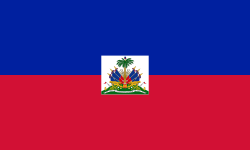This is a list of official National symbols of Haiti
| Symbol | Name | Image | Reference |
|---|---|---|---|
| Flag | The Bicolor |  | [1] [2] |
| Coat of Arms | The Palmiste |  | [1] [2] |
| National Bird | Hispaniolan trogon |  | [1] [2] |
| National Anthem | La Dessalinienne | [1] [2] | |
| National Mottos | [3] [2] | ||
| National Floral Emblem | Hibiscus |  | [1] [4] |
| National Tree | Royal Palm |  | [5] [6] [7] |
| National Sport | Soccer |  | [2] |
| National Dish | Diri ak jon jon, griot | ||
| National Beverage | Rhum, Kleren | ||
| Founding Fathers | Toussaint L'Ouverture, Jean-Jacques Dessalines, Henri Christophe, Alexandre Pétion |  | |
| National Personification | Erzuli Dantor, Katrin | ||
| National Song | Lakay, Tabou Combo | ||
| National Dance | Konpa, Twoubadou, Kontredans, Rara |  | |
| National Costume | Karabela (Female), Zaka (Male) | ||
| National Mountain | Pic Makaya |  | |
| National River | Artibonite River |  | |
| National Language | Haitian Creole | ||
| National Pastime | Dominoes | ||
| National Fruit | Mango Francique | ||
| Patron Saint | Our Lady of Perpetual Succor (Catholicism), Erzuli Dantor (Vodou) |  |